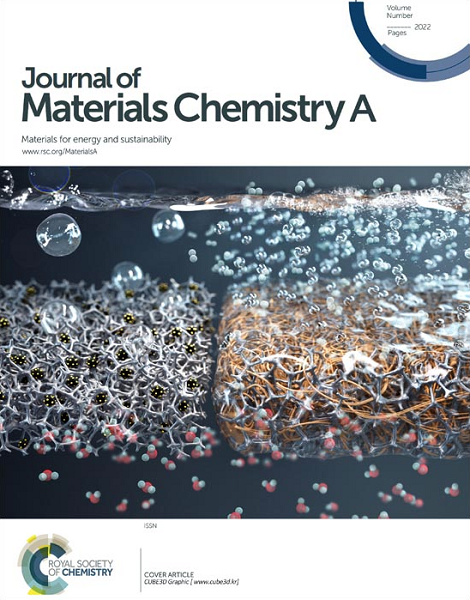富氧空位nfe - mof /Ti3C2Tx MXene复合材料作为高性能杂化超级电容器无粘结剂阴极
IF 9.5
2区 材料科学
Q1 CHEMISTRY, PHYSICAL
引用次数: 0
摘要
随着全球能源需求的不断增长,开发具有高电容和高倍率能力的电极材料对超级电容器来说越来越重要。本文采用一步溶剂热法制备了独立的复合阴极,实现了在Ti3C2Tx mxene装饰的泡沫镍(nfe -MOF/MX/NF)上原位生长二维镍铁金属有机骨架(MOF)纳米片。建筑设计利用了双金属耦合的协同效应和MOF-MXene界面的强相互作用来提高氧化还原动力学和结构耐久性。值得注意的是,Fe的掺入在MOF晶格中诱导了丰富的氧空位,促进了电荷转移和电活性位点的增加。因此,nfe - mof /MX/NF电极在1 a g-1时具有197.0 mAh g-1的高比容量,同时具有出色的倍率性能,在10 a g-1时保持了68.03%的电容。此外,由nfe - mof /MX/NF复合阴极和活性炭阳极组装的混合超级电容器的最大能量密度为40.3 Wh kg-1,峰值功率密度为7500 W kg-1,并且在20,000次循环后具有93.26%的优异电容保持率。这项工作为开发无粘结剂、双金属mof基电极材料和高性能超级电容器的缺陷工程铺平了道路。本文章由计算机程序翻译,如有差异,请以英文原文为准。
Oxygen vacancy-enriched NiFe-MOF/Ti3C2Tx MXene composite as a binder-free cathode for high-performance hybrid supercapacitors
With growing global energy demands, developing electrode materials with high capacitance and rate capability is increasingly critical for supercapacitors. Herein, a free-standing composite cathode was fabricated via a one-step solvothermal method, achieving in situ growth of 2D nickel-iron metal-organic framework (MOF) nanosheets on Ti3C2Tx MXene-decorated nickel foam (denoted as NiFe-MOF/MX/NF). The architectural design leverages synergistic effects of bimetallic coupling and the strong MOF-MXene interfacial interactions to enhance redox kinetics and structural durability. Notably, Fe incorporation induces abundant oxygen vacancies within the MOF lattice, facilitating improved charge transfer and increasing electroactive sites. Consequently, the NiFe-MOF/MX/NF electrode exhibits a high specific capacity of 197.0 mAh g-1 at 1 A g-1, along with outstanding rate performance, retaining 68.03% of its capacitance at 10 A g-1. Moreover, a hybrid supercapacitor assembled with the NiFe-MOF/MX/NF composite cathode and an activated carbon anode achieves a maximum energy density of 40.3 Wh kg-1 and a peak power density of 7500 W kg-1, along with exceptional capacitance retention of 93.26% after 20,000 cycles. This work paves the way for the development of binder-free, bimetallic MOF-based electrode materials with defect engineering for high-performance supercapacitors.
求助全文
通过发布文献求助,成功后即可免费获取论文全文。
去求助
来源期刊

Journal of Materials Chemistry A
CHEMISTRY, PHYSICAL-ENERGY & FUELS
CiteScore
19.50
自引率
5.00%
发文量
1892
审稿时长
1.5 months
期刊介绍:
The Journal of Materials Chemistry A, B & C covers a wide range of high-quality studies in the field of materials chemistry, with each section focusing on specific applications of the materials studied. Journal of Materials Chemistry A emphasizes applications in energy and sustainability, including topics such as artificial photosynthesis, batteries, and fuel cells. Journal of Materials Chemistry B focuses on applications in biology and medicine, while Journal of Materials Chemistry C covers applications in optical, magnetic, and electronic devices. Example topic areas within the scope of Journal of Materials Chemistry A include catalysis, green/sustainable materials, sensors, and water treatment, among others.
 求助内容:
求助内容: 应助结果提醒方式:
应助结果提醒方式:


